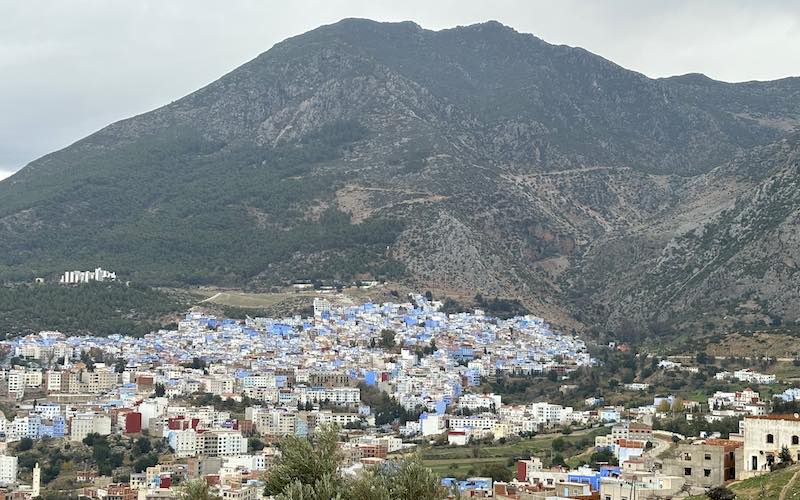Chefchaouen, known as the blue city or the ‘blue pearl’, is a picturesque town located in the Rif Mountains of northern Morocco. Chefchaouen had been relatively undiscovered up until 2019. Just before Covid hit the world, Chefchaouen was really starting to make it on the map. The city saw a massive influx of travellers in that summer, to the extend that many were camping illegally due to all the accommodation being full! Now that Covid is a thing of the past, tourism is starting to return to the blue city again, and it’s easy to see why. Is Chefchaouen worth visiting? Absolutely! Trust me, this place is one of the most fairytale-like destinations that I have ever seen!
Disclosure: templeseeker.com is a participant in the Amazon Services LLC Associates Program and other affiliate advertising programs designed to provide a means for us to earn fees by linking to Amazon.co.uk, Get your Guide and other affiliated sites. Affiliate links may be used in this article on ‘Is Chefchaouen worth visiting?’, but they do not impact on the price that you pay and they do help me to get this information to you for free.
History of Chefchaouen
Chefchaouen was founded in 1471 by Moulay Ali ibn Rashid al-Alami, a descendant of the Islamic prophet Muhammad. The city was established as a fortress to resist the Portuguese invasions of northern Morocco. The strategic location of Chefchaouen, nestled between the Mediterranean Sea and the Rif Mountains, made it an important stronghold.
During the 1920s, Chefchaouen, like much of northern Morocco, fell under Spanish control. The Spanish colonial presence had a significant impact on the town’s architecture and culture. Many of the blue-painted buildings that characterize Chefchaouen today are said to have been introduced by Jewish refugees who settled in the area during this period. The blue colour is believed by some to symbolize the sky and heaven, serving both spiritual and aesthetic purposes.
There are not many Jewish residents left in the city of Chefchaouen, as most of them moved to Israel when the state of Israel was formed in 1948. However, the current residents of the city continue to preserve the tradition of painting the houses blue.
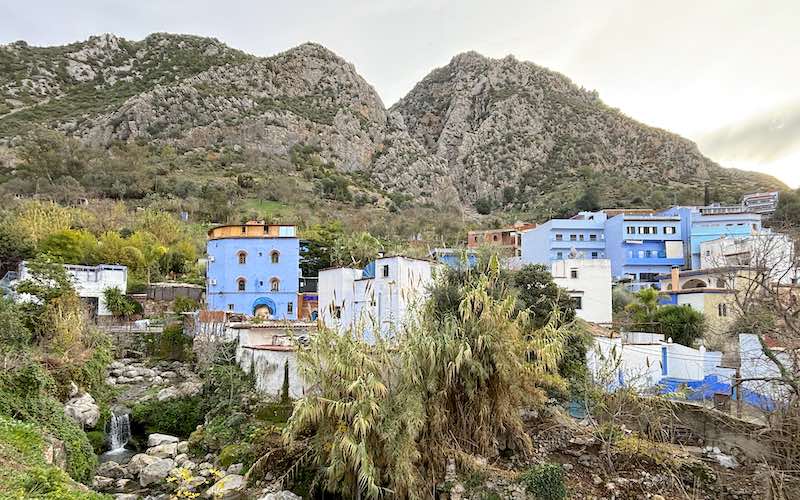
Photography copyright: All the images in this blog are original photography by Amy Green and are property of @templeseeker (unless otherwise stated). Please do not use these without permission or without giving credit. If you would like to use any of these images please email: amy@templeseeker.com for permission.
How to get to Chefchaouen
As it is located in the Rif mountains, it is not straightforward to get to Chefchaouen. There is no train station in Chefchaouen, so taking the train is not an option. Most people do a bus shared transfer or private transfer from Fez or Tangier. I took a shared transfer from Fez to Chefchaouen that I booked on Get Your Guide. The journey took approximately 4 hours with a couple of stops for a viewpoint and a toilet stop. Be aware that the roads are a little windy and there is a bit of altitude (although not as challenging as the Tizi-n-Tichka pass!). If you are prone to travel sickness then I would advise taking some anti-sickness tablets. You could also try using some of the stick on travel sickness patches or the anti-sickness bracelets.
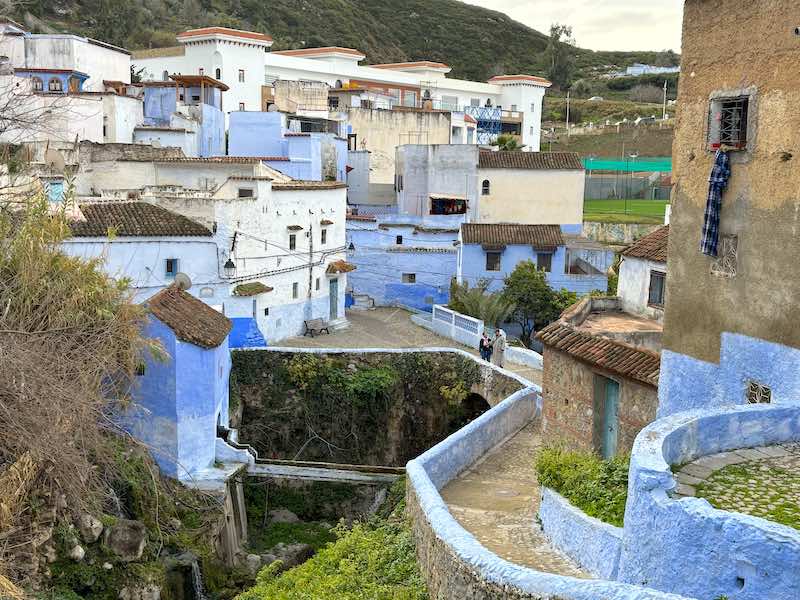
How many days in Chefchaouen?
A lot of people do Chefchaouen as a day trip from Fez or Tangier. From Fez, it takes around three and a half hours to get to Chefchaeouen, so that is a total of around seven hours of travel to spend just a few hours in the blue city. It’s around two and a half hours from Tangier as well, still making it possible, but not favourable. The Medina of Chefchaouen CAN be seen in just three hours or so, but it’s the extensive travel and that rushed feeling that mean I don’t recommend Chefchaouen as a day trip.
I spent three days in Chefchaouen. One day exploring the medina, one day hiking and a third day relaxing. It was the perfect amount of time. I didn’t feel rushed and I also got the chance to enjoy some of the local restaurants. If you are wondering how many days to spend in Chefchaouen then I would recommend two or three. This will also give you time to do some shopping, explore some of the surrounding areas and have a hammam (a traditional Moroccan bath!)
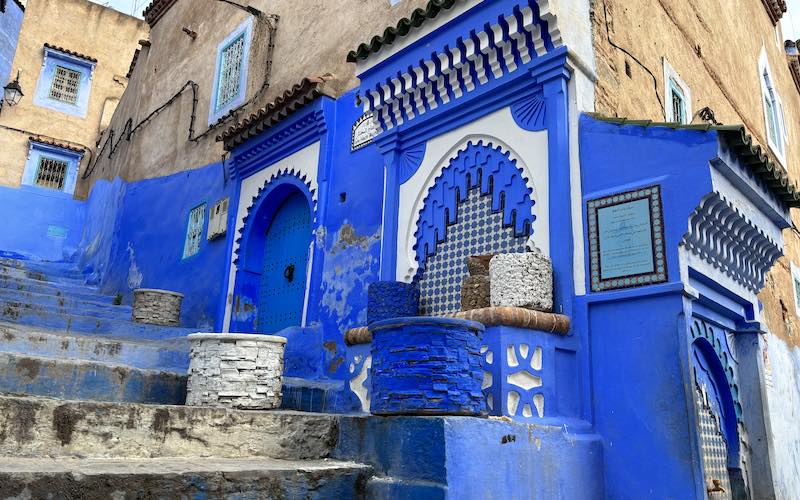
When to visit the Blue City in Morocco
The blue city is best avoided in the height of summer, when temperatures soar above 30°C and the streets are packed with tourists. In December and January, temperatures drop to around 10°C, and may be quite cold at night. Personally, I travelled to Chefchaouen in winter and found it very mild and easy to take pictures without all the crowds!
However, the best time to visit the Blue City is in the shoulder season between March-May and again from September to October. You can expect fewer crowds, temperatures of around 10°C – 20°C and less rainfall. The best months overall to visit Chefchaouen are May and October.
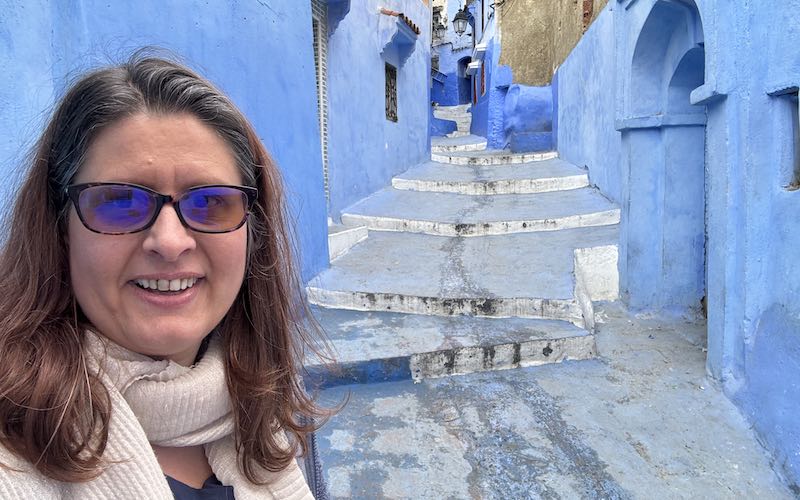
Is Chefchaouen worth visiting?
Chefchaouen is definitely worth visiting, and I would strongly recommend adding it to your Morocco itinerary if you have two or three days to spare. As I’ve mentioned, please don’t try to rush Chefchaouen as a day trip. Part of the enjoyment of Chefchaouen is the relaxing atmosphere of the blue city up in the mountains.
Although there are not many key sites as such, the attraction of Chefchaouen is simply experiencing the Medina. There is a grand mosque and a Kasbah – the fortress walls surround the city. But wondering through the blue meandering streets and photographing the architecture is the main attraction of the experience. Chefchaouen is a city of colour and an Instagrammers dream.
As well as enjoying the blue city itself, there are some other great things to do in Chefchaouen and the surrounding areas. There are some fantastic Moroccan restaurants where you can enjoy a tagine. There are some great shops for handicrafts including wood carvings, art and hand made soaps. You can take a Hammam, a traditional Moroccan bath (with scrub if you like!) in one of several bath houses around Chefchaouen. It’s also a great city for hikers, with short hikes (up to the Spanish Mosque) and longer hikes (such as the Akchour waterfall).
Overall, Chefchaouen is a city that offers a relaxing contrast to some of the larger cities including Marrakech, and gives an extremely authentic Morocco experience.
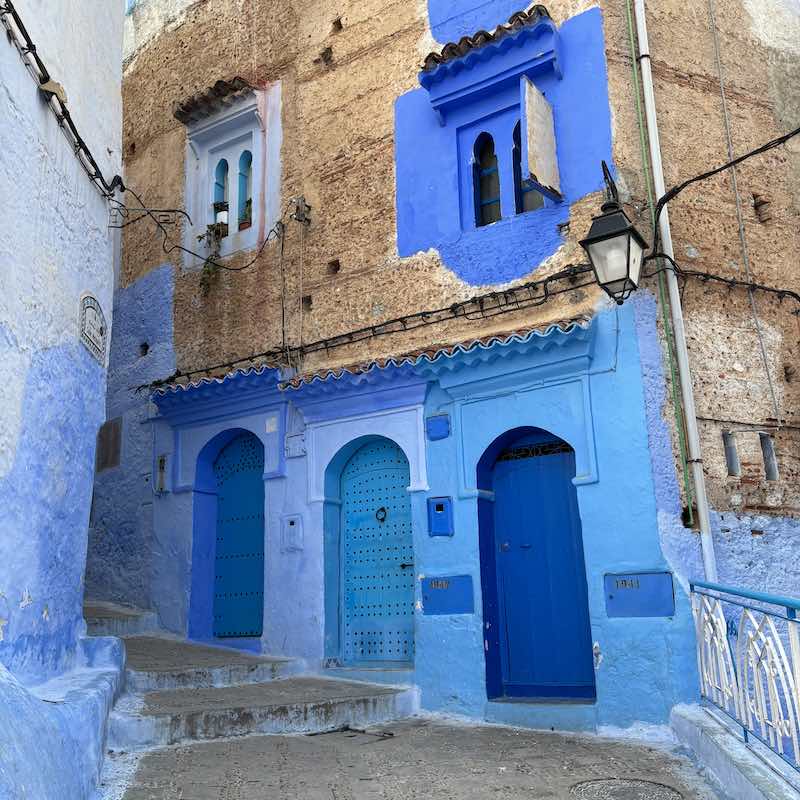
Where to stay in where to stay in Chefchaouen
There are some gorgeous Riads in Chefchaouen. A Riad is a traditional Moroccan house often with a courtyard. Staying in a Riad will give an extremely authentic Moroccan experience. Some of the best Riads located centrally within the medina walls include Riad Nila and Riad Yazid.
If you are looking for a hotel rather than a Riad, I recommend Puerta Azul. They have en suite rooms with internet, TV and laundry facilities. If you are looking for something with more facilities and more spacious, they also have junior suites available with a fridge and lounge. Puerta Azul also offer a great evening menu for just 120 Moroccan Dirhams. The only downside is that it is located just outside the medina walls and it is a bit of a walk into the city (10-15 mins).
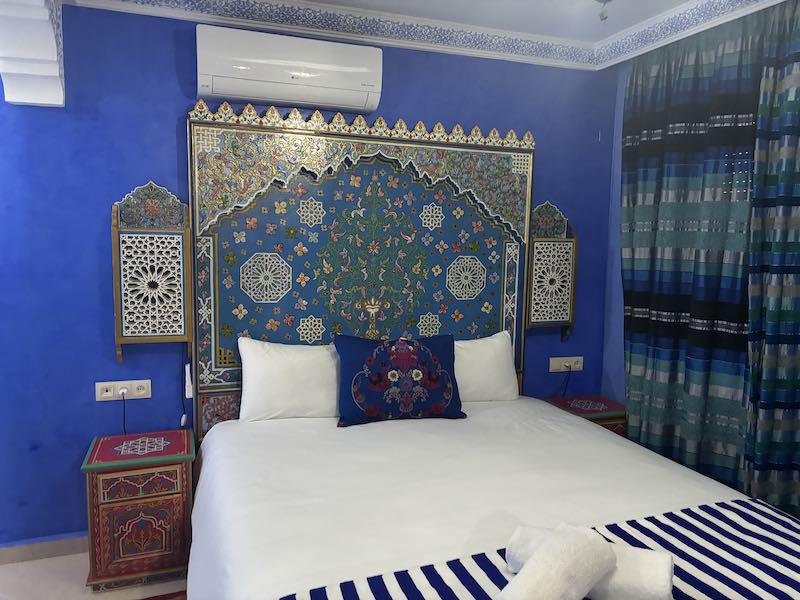
Pros of Chefchaouen
Chefchaouen is an extremely authentic and relaxing destination. As well as seeing the main attractions in and around the city, make sure that you keep some time for shopping, photography and a traditional hammam!
Instagrammable blue city – A Photographers dream
There are not particular monuments for sightseeing as such in Chefchaouen, the attraction is simply the city itself! It is a highly instragrammable destination, so pack your good camera, video equipment and nice clothes.
Choose clothes with contrasting colours such as yellow and orange, rather than blue which can be a mis-match or mean that you don’t stand out in the photos (read more on what to wear in Chefchaouen here).
I would also highly recommend hiring a guide who can do some photography for you, or maybe even a guide and a photographer! These gorgeous streets make fantastic backdrops for portraits and family photos.
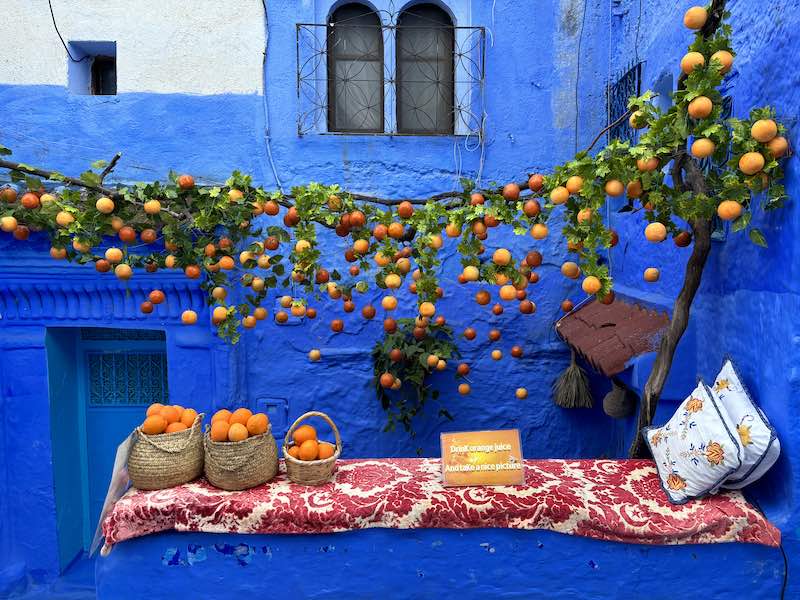
Great souvenir Shopping and local handicrafts
Chefchaouen is a great city for shopping for souvenirs and local handicrafts. Popular crafts in Chefchaouen include wood carving, rug weaving, embroidery and leather work. There are also some great shops with perfumes and soaps hand made using local scents such as argan oil, fig fragrance and orange blossom.
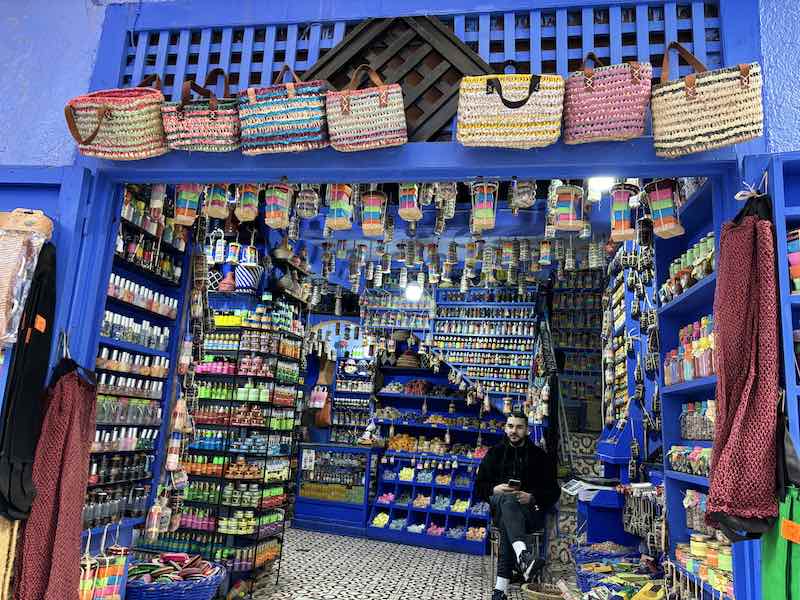
Amazing Moroccan Restaurants
Chefchaouen is a great place to try traditional Moroccan food including Kefta, Tagine and Moroccan salads. Many people go to Casa Alladin on the main square, but it is becoming extremely busy and touristy, especially in high season. I recommend Bab Ssour and Cafe Clock for cheaper and more authentic experiences. I had a gorgeous Kefta (meatballs) with Moroccan sauce, olives and bread at Bab Ssour for just 30 Dirhams which is around £3 or $4.
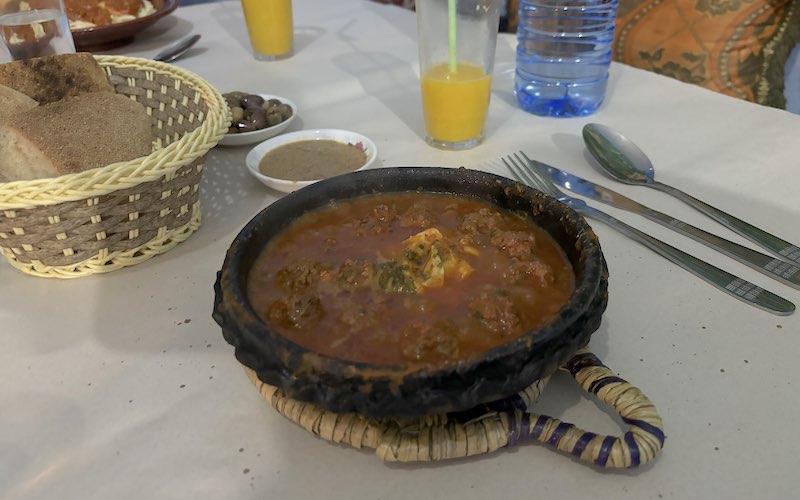
Mountain Views and great Hiking
If you are an enthusiastic hiker, Chefchaouen will be a great destination for you. For a short and popular local hike, take the 20 minute gentle upward walk to the Spanish Mosque. This small white mosque has only just come into use again because of how impractical it was for the people living up the mountain to walk down to the city five times a day to pray.
There are also some more challenging but rewarding hikes in the local area as well. A popular one is The Akchour Waterfalls hike. It is essential to do these hikes with a guide and you can book through Get Your Guide for the Akchour waterfalls here.
The Traditional Hammam Experience
While you are in Chefchaouen, plan some time for a relaxing Moroccan hammam, which is a Moroccan bath house and spa. There are different levels of service such as a hammam that includes a sauna and/or a scrub down. Some of the best ones are Hammam El Balad, Hammam Rahma and Hamam Meslouhi.
Cons of Chefchaouen
Although Chefchaouen is a very beautiful and picturesque city, as with all travel destinations, there are downsides. It is much cooler than destinations such as Rabat and Marrakech and the medina gets slippery when wet. Also, as I’ve mentioned, Chefchaouen is not too easy to get to.
Temperature is lower than other cities such as Marrakech
One thing is for sure – if you travel from Marrakech or Rabat to Chefchaouen in the winter you will surely experience quite a temperature drop. We came from 24°C in Marrakech to 11°C in Chefchaouen in January…it was a bit of a shocker! The lower temperature is fine to deal with, as long as you are well prepared for it.
Pack a few layers such as an Under Armour base layer, a fleece (in a contrasting colour such as yellow) and a waterproof outer jacket such as this Peter Storm one. For your bottom half pack some soft cycling shorts and leggings as well as hiking trousers, so that you can layer up if necessary. Pack some warm hiking socks as well – I like these Bridgedale light weight hiking socks for Morocco.
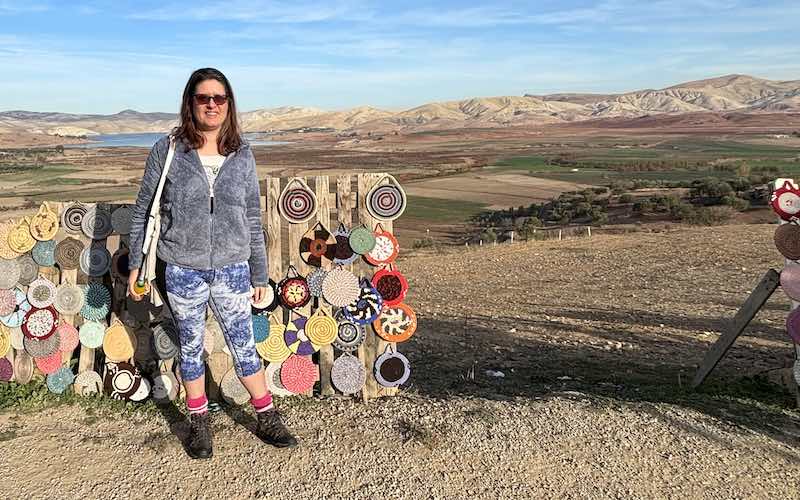
Chefchaouen is not so easy to get to
Chefchaouen is not as easy to get to as other destinations such as Rabat or Marrakech. You will only be able to get there by bus or private transfer, because there is no airport or train station in Chefchaouen. If you get travel sick easily, then you will want to prepare yourself for winding roads and a bit of altitude. You might also want to consider anti-sickness wrist bands or anti-travel sickness patches.
The Medina becomes slippery in winter when it rains
If you visit Chefchaouen in winter, then you need to be aware that the medina is slippery when it rains, and it can rain a lot. This is why it is essential to take a sturdy pair of hiking boots – mine are these Karrimor Bodmin Weatherlite walking boots.
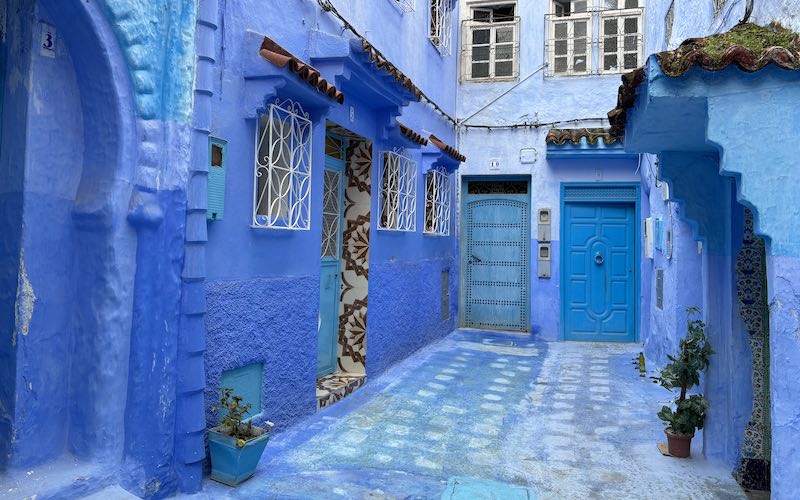
Overall View – Is Chefchaouen worth visiting?
So, overall, is Chefchaouen worth visiting? I vote absolutely, yes! I would want every traveller to see and experience the Blue City of Morocco at some point in their life. This place really is unique, and I’ve never seen anywhere else like it!
Further Reading on Morocco
If you enjoyed this article on ‘Is Chefchaouen worth visiting?’ then you might also like to read…
- What to wear in Chefchaouen
- Visiting Chefchaouen in winter
- Is Meknes worth visiting?
- Things to do in Marrakech

